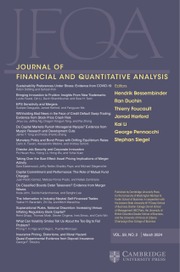No CrossRef data available.
Article contents
The Effect of Takeover Protection in Quiet Life and Bonding Firms
Published online by Cambridge University Press: 02 January 2024
Abstract
Antitakeover measures are controversial because the evidence of their net effect on shareholders is mixed. We propose that, for many firms, the potential bonding benefits outweigh the agency costs of the quiet life, explaining the mixed results. We study business combination and poison pill laws as exogenous shocks to takeover vulnerability and use shareholder valuation of internal slack as an indicator of the net effect of takeover protection. Firms susceptible to quiet life agency problems exhibit a decrease in the market-assessed value of internal slack. Conversely, cash appreciates at companies where takeover protection bonds commitments with major counterparties.
- Type
- Research Article
- Information
- Journal of Financial and Quantitative Analysis , Volume 60 , Issue 1 , February 2025 , pp. 295 - 335
- Copyright
- © The Author(s), 2024. Published by Cambridge University Press on behalf of the Michael G. Foster School of Business, University of Washington
Footnotes
We appreciate helpful comments from an anonymous referee, Mark Chen, Erik Devos (discussant), Ran Duchin, Mara Faccio (the editor), Andrey Golubov, Tom Griffin, Mark Huson, Bill Johnson, Dalida Kadyrzhanova, Jon Karpoff, Omesh Kini, Chis Parsons, Raghu Rau, Luc Renneboog, Nick Travlos, Mike Wittry, Moqi Xu (discussant), seminar participants at Georgia State University, ESTM/Humboldt University in Berlin, University of Missouri, University of Oklahoma, University of Reading, University of Surrey, University of Tilburg, and attendees at the Cass Business School Mergers and Acquisitions Conference, the Frontiers of Finance Conference in Banff, Ontario, and the Southern Finance Association meetings. We thank Randy Heron for sharing his reincorporation data with us and Tom Griffin and David Shin for data collection assistance. All errors are our responsibility.


